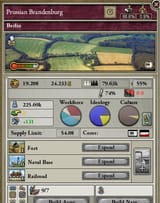Search Results
6/11/2025, 12:53:14 AM
Brandenburg: the Heartland, the Beginning
January 1, 1836
To even begin to describe Prussia and her Majesty, to walk through her steps as she storms across Europe and seizes her rightful clay, one must begin at the capital: Brandenburg, where it all began.
Encompassing 40,000 square kilometers and centered on Berlin, Brandenburg was and is the heartland of Prussia. But it is a dreary place; located on a plain, the countryside attracts few visitors, possess no distinct landmarks, and the rivers are barely more than streams--let alone having some awe of the grandeur of the Rhine or Danube.
In 1598, it was described as a "flat land, wooded and for the most part swamp," "sand," "bogs," and "uncultivated areas." The soil was lacking, nothing like the sheer richness of the soil in the Red River Valley of North Dakota, where some Germans would later flock. The ground was sandy and light, and no trees would grow on it. While Italy has been described as a "geographical expression," Brandenburg was a sore excuse of a piece of land. No defensible natural borders. Landlocked.
It existed purely as a political entity after Christian forces seized land from pagan Slavs and were settled by immigrants. We do not speak of the Slavic history of Brandenburg.
Brandenburg also did not produce any specialized crop-based manufacturing product, such as wine, madder, flax, fustian, wool, and silk, and it lacked key mineral resources--silver, copper, iron, zinc, and tin. There was a single ironworks in Peitz. Agricultural yields were low. In some places, the soil was such that it could only be sown every 6, 9, or 12 years, if it could even be sown at all.
Brandenburg was a godforsaken land of little character or strategic merit. What it did have, however, were the Hohenzollerns, whose ambitions would take this stretch of blasted land and make it the heart of the greatest Empire, stretched from the Baltic to the Atlantic to the Mediterranean.
January 1, 1836
To even begin to describe Prussia and her Majesty, to walk through her steps as she storms across Europe and seizes her rightful clay, one must begin at the capital: Brandenburg, where it all began.
Encompassing 40,000 square kilometers and centered on Berlin, Brandenburg was and is the heartland of Prussia. But it is a dreary place; located on a plain, the countryside attracts few visitors, possess no distinct landmarks, and the rivers are barely more than streams--let alone having some awe of the grandeur of the Rhine or Danube.
In 1598, it was described as a "flat land, wooded and for the most part swamp," "sand," "bogs," and "uncultivated areas." The soil was lacking, nothing like the sheer richness of the soil in the Red River Valley of North Dakota, where some Germans would later flock. The ground was sandy and light, and no trees would grow on it. While Italy has been described as a "geographical expression," Brandenburg was a sore excuse of a piece of land. No defensible natural borders. Landlocked.
It existed purely as a political entity after Christian forces seized land from pagan Slavs and were settled by immigrants. We do not speak of the Slavic history of Brandenburg.
Brandenburg also did not produce any specialized crop-based manufacturing product, such as wine, madder, flax, fustian, wool, and silk, and it lacked key mineral resources--silver, copper, iron, zinc, and tin. There was a single ironworks in Peitz. Agricultural yields were low. In some places, the soil was such that it could only be sown every 6, 9, or 12 years, if it could even be sown at all.
Brandenburg was a godforsaken land of little character or strategic merit. What it did have, however, were the Hohenzollerns, whose ambitions would take this stretch of blasted land and make it the heart of the greatest Empire, stretched from the Baltic to the Atlantic to the Mediterranean.
Page 1
